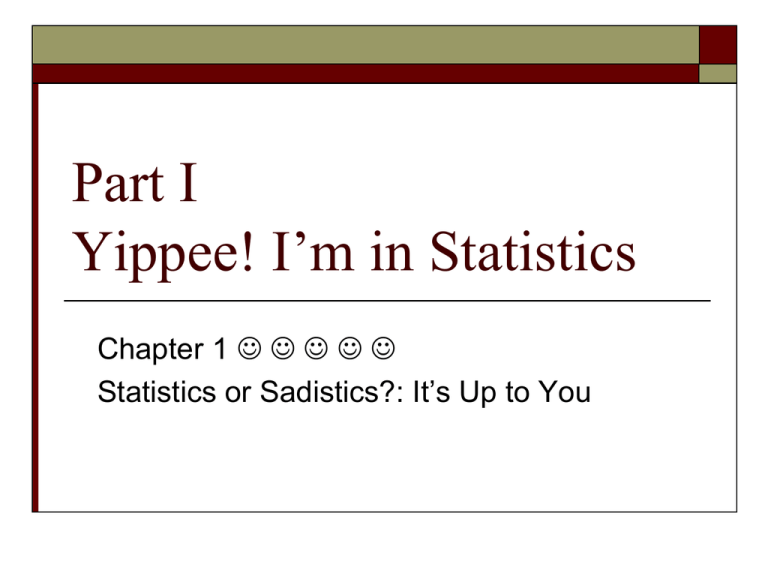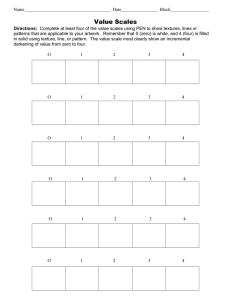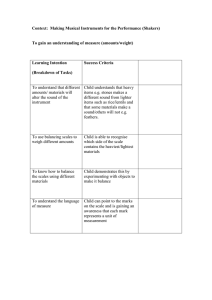Part I Yippee! I’m in Statistics
advertisement

Part I Yippee! I’m in Statistics Chapter 1 Statistics or Sadistics?: It’s Up to You Why Statistics? Statistics for People Who (Think They) Hate Statistics Follows an approach that is: Un-intimidating Informative Applied Even a little fun! A Five-Minute History 17th century the first set of data pertaining to populations was collected Need arose to develop specific tools to help answer specific questions Basic statistical procedures were developed in the fields of Agriculture Astronomy Politics Statistics: What It Is (and Isn’t) Statistics describes “a set of tools and techniques that is used for describing, organizing, and interpreting data.” The text will help you learn how to do the following with data: Collect Organize Summarize Interpret Descriptive or Inferential? What is Descriptive Statistics? Used to organize and describe the characteristics of a particular data set Example: the average age of everyone in this class! What is Inferential Statistics? Used to make inferences from your “sample” to the “population” Example: comparing the mean age of students taking this course to average age of all students in an introductory statistics course Why Statistics is Important Understanding basic statistics will help you in the following ways: Better prepare you for advance courses (both undergraduate or graduate) Sets you apart from those who do not take courses in statistics Challenges you intellectually Makes you a better student in the behavioral or social sciences!! Success in this Course A few hints for successful completion of this course You’re not dumb How do you know statistics is hard? Don’t skip lessons!! Form a study group Ask questions Work through the exercises in each chapter Practice, Practice, Practice Look for real-world applications Browse HAVE FUN!! About Those Icons Key to Difficulty Index VERY Hard Hard Not too hard, but not too easy Easy VERY Easy Glossary Terms to Know Descriptive statistics Data or data set Inferential statistics Population Sample Algebraic Order Parentheses and Brackets -- Simplify the inside of parentheses and brackets before you deal with the exponent (if any) of the set of parentheses or remove the parentheses. Exponents -- Simplify the exponent of a number or of a set of parentheses before you multiply, divide, add, or subtract it. Multiplication and Division -- Simplify multiplication and division in the order that they appear from left to right. Addition and Subtraction -- Simplify addition and subtraction in the order that they appear from left to right. PEMDAS Important: It is not correct to say that we must always do addition before subtraction, because A comes before S in PEMDAS For example: 4 - 1 + 7 - 2. We get 8 working left to right Another example: 5 x 6 ÷ 2 ÷ 5. We get 3 working left to right. Now You Try! 2+5*X 2+(3-1) * 32 5- (10)2 /50 Sqrt [ 5(8) – (4)2 ] [ 3(6) –(3)2 ] Learning a new language Types of variables How it can be measured matters Discrete variables What is measured belongs to unique and separate categories If there are only two categories, then it is called a dichotomous variable Chapter 1 Pets: dog, cat, goldfish, rats Open or closed; male or female 14 Learning a new language Types of variables Continuous variables What is measured varies along a line scale and can have small or large units of measure Chapter 1 Length Temperature Age Distance Time 15 Learning a new language Measurement scales: Nominal Measurement scales Nominal scales Separated into different categories All categories are equal There is no magnitude within a category Chapter 1 Cats, dogs, rats NOT: 1st, 2nd, 3rd One dog is not more dog than another. 16 Learning a new language Measurement scales: Nominal No intermittent categories Chapter 1 No dog/cat or cat/fish categories Membership in only one category, not both Mutually exclusive properties 17 Learning a new language Measurement scales: Ordinal Ordinal scales What is measured is placed in groups by a ranking Chapter 1 1st, 2nd, 3rd 18 Learning a new language Measurement scales: Ordinal Although there is a ranking difference between the groups, the actual difference between the group may vary. Marathon runners classified by finish order The times for each group will be different Top ten 4- to 5-hour times Bottom ten 4- to 5-week times Time 1st place Chapter 1 2nd place 3rd place 19 Learning a new language Measurement scales: Interval Interval scales Someone or thing is measured on a scale in which interpretations can be made by knowing the resulting measure. The difference between units of measure is consistent. Height Speed Length Chapter 1 20 Learning a new language Measurement scales Ratio scale Just like an interval scale, and there is a definable and reasonable zero point. Time, weight, length -20 Chapter 1 -10 0 +10 +20 Seldom used in social sciences All ratio scales are also interval scales, but not all interval scales are ratio scales 21





